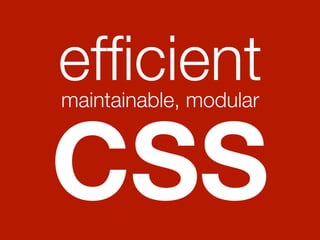Efficient, maintainable CSS
- 2. Here are some quick tips for creating efficient, maintainable CSS.
- 3. Applying CSS
- 4. 1. Avoid using inline styles as they are hard to maintain and increase file size. Avoid <body> <h2 style=“color: red;”> ! Heading here </h2>
- 5. 2. Avoid using header styles as they are also hard to maintain and increase file size. Avoid <style> p { color: red; } </style>
- 6. 3. Avoid using @import within the HTML as this will slow down IE browsers. Avoid <style> @import "a.css"; </style>
- 7. 4. Avoid using multiple CSS files, or use a script to combine all CSS files into one. <link rel="stylesheet" href=”reset.css"> <link rel="stylesheet" href=”grids.css"> <link rel="stylesheet" href=”text.css"> <link rel="stylesheet" href=”modules.css"> <link rel="stylesheet" href=”colors.css"> Avoid
- 9. 5. Use multiple declarations where possible p { ! margin: 0 0 1.5em; ! background: green; }
- 10. 6. Use multiple selectors where possible h1, h2, h3, h4, h5 { ! color: #666; ! margin: 0 0 .5em; }
- 11. 7. Use shorthand properties where possible. body Avoid { margin-top: 20px; margin-right: 10px; margin-bottom: 20px; margin-left: 10px; } Preferred body { margin: 20px 10px; }
- 12. 8. Avoid !important as it is often unnecessary. p { margin: 0 !important; } Avoid
- 13. 9. Avoid complex selectors. Try to be only as specific as needed. Avoid .nav ul li a { margin: 0; } .nav a { margin: 0; } Preferred
- 14. 10. Avoid universal selectors due to performance issues. .nav * { margin: 0; } Avoid
- 15. 11. Avoid qualifying selectors as this is often unnecessary. Avoid div.nav { } .nav { } Preferred
- 16. 12. Avoid IE-proprietary filters as they slow page performance. Avoid filter:Alpha(Opacity=40); -ms-filter: "Alpha(Opacity=40)";
- 17. 13. Avoid IDs. Where possible, use classes instead. Avoid #header { ... } .header { ... } Preferred
- 18. 14. Try not to use use too many font-size declarations. h1 { font-size: 200%; } .nav { font-size: 80%; } Avoid .widget { font-size: 70%; } .intro { font-size: 110%; } .sidebar { font-size: 85%; }
- 19. Optimisation
- 20. 15. Use a CSS minifier to reduce your overall CSS file size: http://refresh-sf.com/yui/
- 21. 16. Optimise images as much as possible
- 22. 17. Where possible, combine images into sprites. http://designsbynickthegeek.com/tutorials/social-menu-icon-sprites
- 23. 18. Where possible, use CSS3 instead of images to reduce server requests and page size. Avoid p { background: url(round-corners.png); } p { border-radius: 10px; } Preferred
- 24. Russ Weakley Max Design Site: maxdesign.com.au Twitter: twitter.com/russmaxdesign Slideshare: slideshare.net/maxdesign Linkedin: linkedin.com/in/russweakley

